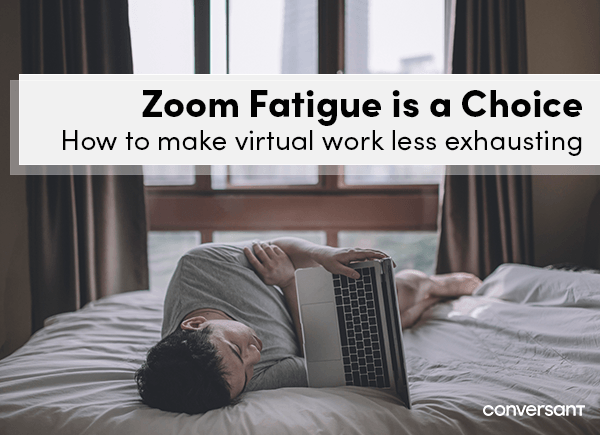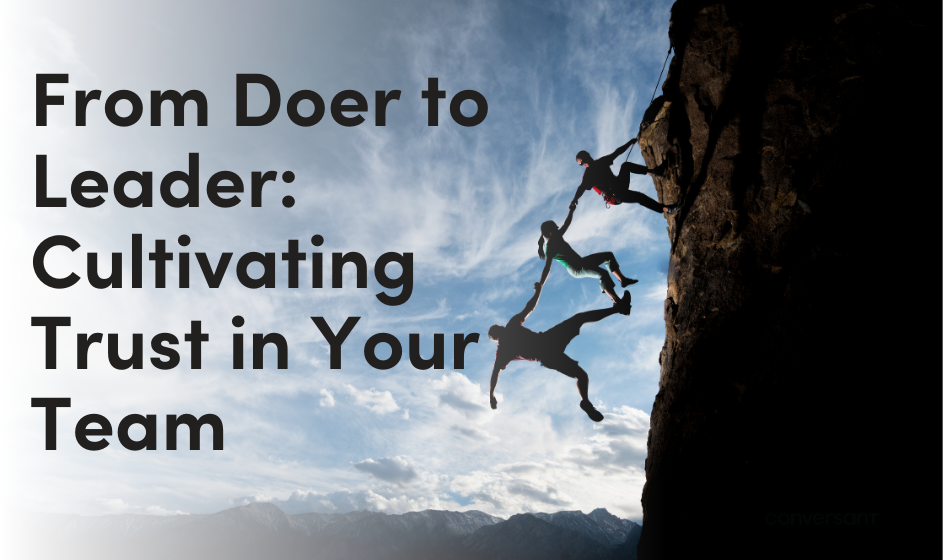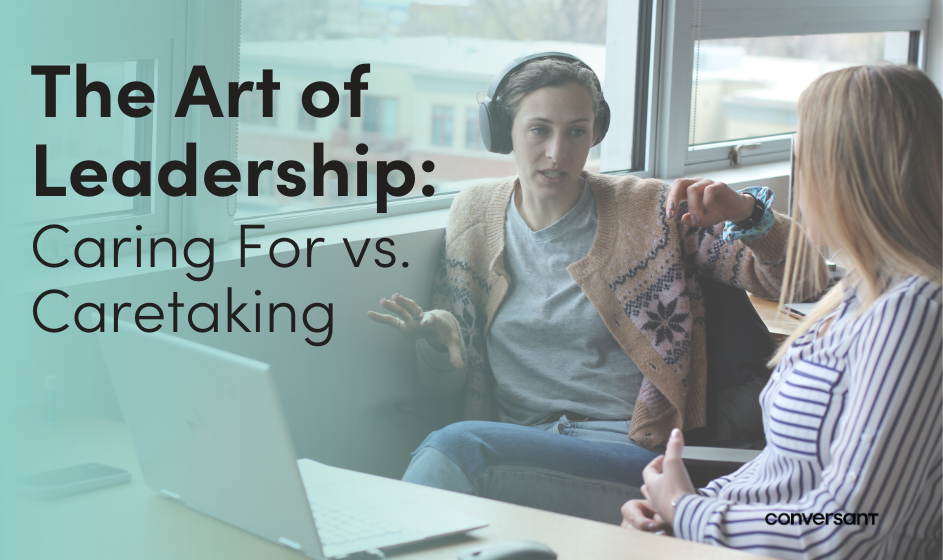Your Zoom Fatigue is Your Fault
With so much of our lives shifting to virtual in the past year, the concept of “Zoom fatigue” has become an easy excuse to avoid taking responsibility for our choices, and the scapegoat for everything we find wrong with virtual calls. While many companies are beginning to consider what a return to an office might look like, the high likelihood is that virtual work is here to stay, whether your organization chooses to stay virtual and dispersed or adopt more of a hybrid set of expectations. So, what can we do about it?
The truth is, we have control over a lot more than we recognize and by making smarter choices, we can minimize and, in some cases, eliminate the causes of “Zoom fatigue” while continuing to benefit from the opportunities that virtual work provides.
Of course, I will concede that “Zoom fatigue” is a legitimate thing (even the CEO of Zoom himself says he has it). There are neurobiological and psychological explanations for why sitting in front of screens for hours on end can leave us exhausted and demoralized. There are also larger pandemic and chronic-stress-related reasons for why we are all feeling drained and overwhelmed. While important, I will not cover these here (there is a ton already written about them that you can find easily with a quick Google search). Right now, we have very little control over those factors, but there are things we DO have control over, including how we can make our virtual work enjoyable and rewarding.
Many of the causes of “fatigue” we are all experiencing are either temporary (chronic stress and social isolation due to the pandemic) or minor in the grand scheme of things (the drain we feel because connecting through technology is not yet capable of fully matching an in-person, biological connection). Most, however, are due to the poor design of our workflow and our virtual meetings. We have all fallen into unconscious patterns and routines over the last year, but we can make different choices and create new patterns and routines that support how we work best.
Focus, focus, focus
One of the biggest drains on our energy is multi-tasking. It does not matter how good you think you are at multi-tasking; you aren’t. The research is conclusive and irrefutable: multi-tasking increases our cognitive load, leaving us tired and less productive than those who have learned to single-task well. Before the pandemic, we were already being bombarded by notifications and interruptions from everywhere: email, texts, Slack, Teams, Instagram, Facebook, LinkedIn, calls that can interrupt us at any time because we are never without our phones, people popping in to our office to ask a quick question. We were overwhelmed and fatigued before the pandemic even began!
Now that so many of us are working virtually, those same distractions still exist and have only been exacerbated. It is now even easier to check our email, respond to chat messages, and browse the Internet, all while “participating” in a video call. No wonder we are all so exhausted! It is common to do this out of boredom or procrastination, or because we are overwhelmed by all there is to do in a day. Many of us have a perception that we are expected to immediately respond to messages, and others just hate to let them build up and risk a panic attack.
I will be the first to admit that it is hard to focus with so many distractions, and I am not perfect. Managing these distractions and increasing my “focus time” has become my mantra in the past few years. Before the pandemic, I was convinced that the superpower of the future is the ability to focus in an increasingly distracting world. I am even more convinced now.
We can easily sit in front of a TV and binge-watch 10 hours of a Netflix show we are addicted to. People who love video games can play for hours, even days, talking and chatting with their fellow gamers all while intensely engaging in a game that covers the full range of human emotions from stress to disappointment, anger to ecstatic joy. I find it hard to believe that screens are the problem.
If you think about it, we naturally minimize multi-tasking while binge-watching a Netflix show or gaming with friends (anyone who has ever tried to multitask during a serious game knows how that goes). It is the multi-tasking, constant task-switching, and resulting cognitive load we impose on ourselves daily that is the major source of our “Zoom fatigue.”
Get up & move!
We are not designed to sit on our butts in the same chair without moving all day. We already know this—it is why stand-up desks have been so in demand the last few years. It has been said that “sitting is the new smoking,” although standing all day is not good for you, either. We were meant to move, and working from home has made this even more challenging.
Without having to move from meeting room to meeting room, it is easy now to schedule meetings back-to-back all day without a moment to get up and take a break. These days, most calls seem to start with people running a few minutes late because they had to squeeze in a bathroom break, or with apologies as we quickly eat our lunch because we simply have not had the time. This is insane! We have become victims of the unconscious structures and rhythms we slipped into with our shift to virtual work, but it does not have to be this way.
“My clients will be unhappy if I ask to end early” is a common argument. “What’s early?” I usually ask. Our common meeting times—an hour, 30 minutes, 90 minutes—are all arbitrary and only make sense because of where they land on the clock, an analog clock at that! 25 minutes instead of 30, 45 or 50 minutes instead of 60, or 75 minutes instead of 90 are all just as arbitrary and just as valid. I am willing to bet that most of your clients and customers will appreciate the breathing room because they are likely scheduled back-to-back too. Even just starting your meetings at 5 minutes after the hour gives everyone a quick break and opportunity for a conscious transition.
A caveat: If you then use the 5, 10, or 15 minutes between meetings to click through your email, browse social media, or take a quick call, you defeat the purpose of having that time and you will continue contributing to your “fatigue.” Instead, get up and move. Walk around your house, or around the block. Do a few stretches or pushups. Anything to get your blood moving and to change your position and environment for even a few minutes. All of it will reenergize you, help you stay focused, and decrease the fatigue you feel at the end of the day.
Returning to the office won’t fix your fatigue. Your habits will.
I am convinced that much of why people think working in an office is less fatiguing than working virtually is because the rhythms and structures of office life have evolved for decades to make good choices for us. It is harder to have back-to-back meetings, especially if you have to walk between buildings. Even if the room you are moving to for your next meeting is across the hall, you must get up, physically move, and walk across the hall. You cannot multitask during meetings as easily because your colleagues are sitting around the table with you and they will notice your divided attention (although I have noticed a troubling trend toward more of this, even in person).
In an office, we more easily stay focused on being with the people in the room with us. We bring our lunch and convene in the kitchen or go out to grab something together at a restaurant nearby. Once again, we get up, we move, and because we are talking with our colleagues, we let ourselves be less distracted by our devices. By the end of the day, we have spent a little more of our time single-tasking and moving and a little less of our time in the highly draining world of immobile multi-tasking.
Best of both worlds?
So, what is the answer? I strongly believe that combining the best of both our virtual and in-person work is the smartest path forward. This past year has revealed what is possible to accomplish virtually and clarified the unique benefits of being in person together. The happiest and most successful of us will be the ones who learn from these lessons and take advantage of the strengths of each. To do this, we will first need to take back control of our work lives by designing our days to minimize the habits and behaviors that exacerbate fatigue and maximize those that create enjoyable and fulfilling work.
I would argue that everything I have said can (and should!) be applied to in-person work, too:
- Single-task and focus
- Turn off notifications and remove distractions for chunks of “focus time.”
- Schedule breaks and time to eat on your calendar every day (and do your best to treat them as essential ingredients to productive and successful work).
- Set a timer and get up and move as often as possible. If you have a meeting that can be done over the phone, make it a walking meeting.
“Office life” has had decades to establish rhythms and routines in our work that create balance throughout the day. We can do the same with “virtual life”—we just need to be intentional and design our days and the way we work to be in better harmony with what we need to thrive.
In the coming weeks, I will share more about what I am personally experimenting with to make work and life more enjoyable, engaging, fulfilling, and less fatiguing. You can find me on LinkedIn, or sign up for our newsletter to stay up-to-date.




